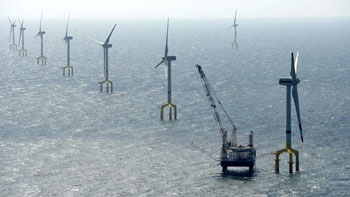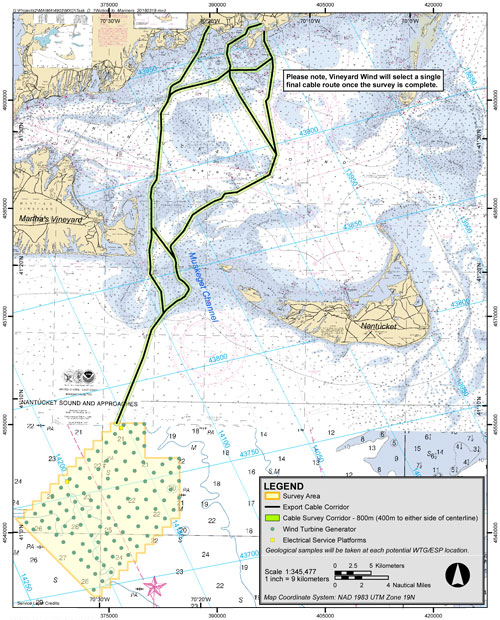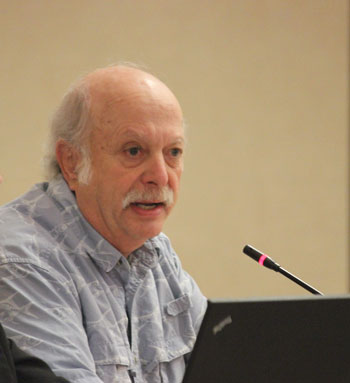Habitat and Offshore Wind Lines
Being Drawn
by Laurie Schreiber

German wind generators in the North Sea, the most developed offshore wind area.
MYSTIC, Conn.—At its April meeting, the New England Fishery Management Council (NEFMC) received an overview of offshore wind energy initiatives in the Atlantic region.
But fishery interests expressed concern about impacts of offshore wind projects on the ecosystem and on the fisheries.
Drew Minkiewicz, a partner at the law firm Kelley, Drye, and Warren in Washington D.C., where he represents the industry group Fisheries Survival Fund (FSF), noted that fishing impacts on habitat have been in discussion for years. Yet, he said, BOEM is “charging full force ahead and looking to absolutely alter the habitat for hundreds of square miles of fishing bottom.” NEFMC “has been too silent and not engaged on this process,” he continued. “We need collectively to engage on this. This is a major issue…This absolutely alters the entire ecosystem. And we don’t even know the full impact.” The fishing industry, he said, has “zero confidence” that it will be able to fish in wind management areas. “This is way more impactful on habitat than fishing gear,” he said. “But wind energy gets a free pass. It’s unconscionable.”
One fisherman called BOEM’s plans “myopic.” He continued, “Another big business versus little guy deal is unacceptable,” and asked NEFMC to act as custodians of the fisheries. “You guys are our partner in developing a fishery for New England that is enduring,” he continued. “It’s part of our culture, it’s who our community is, it’s how we define ourselves. And if we emerge out of this as displaced fishermen, we have failed. At the very least, we need to recognize that fishing is an important and essential of part of life in New England and Long Island. We don’t need to negotiate our exit. We don’t need to negotiate our ruin. We need to dig in and say proudly that we deserve to exist.” The best path forward includes renewable energy, he said. “But we should not be settling for the haves and the have-nots. We should not demand anything less than the successful implementation of wind energy into a thriving fishery.”

The offshore energy company Vineyard Wind is reminding fishermen that it has
begun conducting geotechnical surveys in the Vineyard Wind Lease Area and
between the lease area and Cape Cod, including Muskeget Channel and Nantucket
Sound. Contact Fishery Representative Jim Kendall with questions. 508-287-2010
According to a NEFMC news release, the federal Bureau of Ocean Energy Management (BOEM) is collecting public comment on several projects. Since the comment periods end before NEFMC meets again June 12-14 in Portland, NEFMC authorized its habitat committee and staff to draft comment letters for the following solicitations:
• Vineyard Wind – BOEM has issued a notice of intent to prepare an Environmental Impact Statement;
• New York Bight – BOEM has issued a “call for information.” NEFMC’s letter, among other things, will include an analysis of fisheries active in the call areas;
• Massachusetts Areas – BOEM has issued a proposed sale notice for additional lease areas off Massachusetts. Within its comments, NEFMC will express its position that, if granted, any lease provisions should require developers to have a fishery communication plan and fisheries liaison;
• Path Forward – BOEM is collecting comments on a proposed “path forward for offshore wind leasing.” In addition to providing specific suggestions, NEFMC will request a 90-day extension to the May 21 comment deadline.
At their April meeting, NEFMC members expressed concerns about the ability of mobile fishing fleets to navigate within and around wind arrays, which, they said, could result in exclusion from the areas.
With regard to their comments on the wind management areas, NEFMC member Michael Sissenwine proposed noting potential impacts on endangered species, particularly North Atlantic right whales. “That’s not normally in our mandate,” he said. “But the impact of endangered species often falls on the fishing industry.”
NEFMC member Eric Reid said regulators should also consider the potential impacts on right whales and other species of underwater seismic testing as well as underwater noise generated by construction of wind projects. “Sound travels a very long way in the water,” he said. “The hearing capacity of right whales is a fairly low frequency. I don’t know how that coincides with seismic testing, but we’re doing a lot more seismic testing now and we’re losing a lot more right whales….It’s a unique coincidence we ought to think about.”
With regard to comments for the New York Bight wind area, Minkiewicz said FSF has prepared maps looking at 30-plus years of National Marine Fisheries Service (NMFS) federal surveys overlaid with the areas. “They’re chockablock full of scallops and have been for last 30 years,” he said. Minkiewicz said the area south of Long Island is not necessary for wind development in order to fulfill the state of New York’s energy mandate. “There’s a lot of talk about fulfilling New York’s mandate for renewable energy,” he said. “These are federal, not New York, waters, so I don’t see why one governor gets to dictate what happens in federal waters. If you look at what’s already been leased out and how much power can be produced per square mile with today’s technology” Massachusetts or Rhode Island’s wind areas can generate the energy needed to fulfill the New York mandate, he said. The New York area, he said, “has incredible conflicts with fishing. So why go forward with something so conflicted?...That area south of Long Island is critical for scallops, squid, and so many fisheries.”
Ronald Smolowitz, also with FSF, suggested that a working group of fishermen should be formed to provide insight into the issues and data needs. Survey and vessel monitoring system data, he said, aren’t adequate for understanding impacts around wind sites. “When we’re looking at wind turbine sites, they’re such small areas that we start triggering confidentiality problems,” he said. That means existing data is not useable for showing the heavy fishing in those areas, he said. “I think you need to get industry input to expand the council’s capabilities in addressing these issues,” he said.

Ron Smallowitz, Fisheries Survival Fund. “Existing data is not useable for showing the heavy fishing in those areas. I think you need to get industry input to expand the council’s capabilities in addressing these issues.” Fishermen’s Voice photo
According to BOEM’s “path forward” notice in the Federal Register, BOEM has completed seven offshore wind lease sales for wind energy areas in the Atlantic Ocean offshore Massachusetts, Rhode Island, New York, New Jersey, Maryland, Virginia, and North Carolina. BOEM has issued 13 commercial leases from Massachusetts to North Carolina.
BOEM’s “path forward” intent, the notice says, “is to start a conversation surrounding its approach to future renewable energy leasing” on the Atlantic Outer Continental Shelf. “BOEM believes that additional areas of the Atlantic may be viable for responsible and informed commercial wind development.” BOEM plans to identify ‘‘forecast areas’’ along the Atlantic Coast “that have the highest probability for offshore wind development.”
According to the notice, factors “at this time” that would exclude wind development include National Park System and other federally protected areas; Department of Defense areas; maritime navigation conflict areas, although a later area identification process could result in a case-specific analysis.
Some areas of the outer contintental shelf were previously removed from consideration for leasing for a variety of different reasons. “In most cases, they were removed for reasons that remain applicable today, such as certain high value fishing areas off the coasts of Massachusetts and Rhode Island, essential fish habitat offshore New York, and vessel traffic offshore Maryland and New Jersey,” the notice says.
In addition, the notice says, “BOEM recognizes that an offshore wind energy facility may present viewshed concerns for coastal stakeholders. In BOEM’s previous area identification efforts, it has imposed various buffer distances from shore to address concerns about potential visual impacts of wind development. The buffers are typically greater than or equal to 10 nm from shore.”
BOEM has chosen a 60-meter depth as a factor in identifying forecast areas. “However, BOEM recognizes the recent development of floating wind turbine technologies that may be deployed in deeper waters,” the notice says.
According to BOEM’s NY Bight notice in the Federal Register, the state of New York has a goal of developing 2.4 GW of offshore wind energy by 2030. The state asked BOEM to consider two areas in the Atlantic Ocean south of Long Island that as potential Call Areas. “The State of New York concluded that the areas identified in their Area for Consideration document presented ‘the fewest conflicts with ocean users, resources, infrastructure, and wildlife, and has the greatest potential for cost-effective development of offshore wind energy to meet [their] goals,’” according to the notice.
The notice continues, “BOEM recognizes that several commercial and recreational fisheries operate in the Call Areas, including, but not limited to: Butterfish, Atlantic mackerel, Atlantic sea scallop, Atlantic surfclam and ocean quahog, longfin and Illex squid, monkfish, Northeast multispecies, summer flounder, scup, and black sea bass fisheries….BOEM is also aware that several areas identified by the New Jersey Department of Environmental Protection’s Sport Ocean Fishing Grounds atlas are within the Call Areas. These areas include Yankee Spot, Mako
Hotel, George’s Bank, Bacardi, Triple Wrecks North, Texas Tower, The Slough, Little Italy, Yellowfin Lump, North East Lump, Mako Hole, The Fingers, Resor Wreck, Dusky Hole, Triple Wrecks South, The Bomb, and Glory Hole.”
The notice continues, “If BOEM concludes that fisheries conflicts cannot be properly mitigated in certain portions of the Call Areas, it may exclude those areas from leasing at the Area Identification stage, during the environmental review process conducted under NEPA, and/or as a result of essential fish habitat consultations under the Magnuson-Stevens Fishery Conservation and Management Act. BOEM may also require measures to mitigate or avoid fishery conflicts at the construction and operations phase of its regulatory process.”
ESA-listed species are known to be present in the Call Areas, but the areas do not contain NMFS-designated critical habitat for any ESA-listed species, the notice says.
Off Massachusetts, Vineyard Wind is proposing the construction and operation of an 800MW facility, potentially constructed in two 400 MW phases up to five years apart, according to the BOEM Federal Register notice on that project. Vineyard Wind’s plan proposes installing up to 106 wind turbine generators, each with a capacity of between 8 and 10 MW. Foundations would likely be monopoles, jackets, or a combination of both. The proposed facility would also include two to four offshore substations or electrical service platforms. The potential export cable landfalls identified by Vineyard Wind include sites near the towns of Yarmouth, Barnstable, and Nantucket in the Commonwealth of Massachusetts. Onshore construction and staging would take place at the New Bedford Marine Commerce Terminal facility. At its nearest point, the project area is approximately 14 miles from the southeast corner of Martha’s Vineyard and a similar distance from the southwest side of Nantucket.
